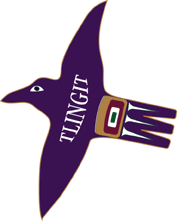 Living
in a Fish Camp Living
in a Fish Camp
ELEMENTARY CURRICULUM GUIDE
Grades K - 5
JUNEAU INDIAN STUDIES PROGRAM
City and Borough of Juneau School District
JUNEAU INDIAN STUDIES PROGRAM
10014 Crazy Horse Dr.
Juneau, Alaska 99801
Department of Education
Title IV-A Indian Education Act
Grant #N008500191
*NO portion to be reproduced without
the written consent of the Juneau Indian Studies Program.
THIRD
GRADE
Alaska is a very unique state with many
distinct cultures. The third grade unit is designed to introduce
students to the culture diversities found in Alaska.
After having a sound base of Alaska's
cultures, the students focus on the Tlingit people of southeastern
Alaska. Students are exposed to the Tlingit's complex social
structure, their way of life and their main cultural celebration;
the potlatch.
Through hosting a potlatch for the second
graders, students develop an understanding of the Tlingit's
relationship to one another and the great respect shown to each
other.
Social Studies Emphasis: Introduction to
Differing Groups
TEACHER INFORMATION
SUMMARY
UNIT: Planning and Hosting a Tlingit
Potlatch
PURPOSE:
Through role playing a Tlingit Potlatch students gain an
understanding of cultural ceremonial practices, their art forms and
their respect for Nature students expand their knowledge of the
Tlingit people.
Day 1
Alaska's
Cultures
Knowledge:
- Name the main Alaska Native
Cultures and their locations
Skills:
- Color code cultures on a map of
Alaska
Day 2 Tlingit Social
Structure
Values:
- Sense of identity
- Respect for others
Knowledge:
- Tlingit social structure
-Moieties
-Clans
-Emblems
-matrilinealty
Skills:
- Observation
- Role playing
- Listening skills
- Participation
Day 3 Tlingit Clan
House
Values:
Knowledge:
- Tlingit people live in clan
houses
- Tlingit people celebrate by having
Potlatches
Skills:
- Reading aloud
- Identifying artifacts and
photos
- Handling artifacts and photos
carefully and with respect
Day 4 Potlatch
Procedures
Values:
Knowledge:
Skills:
- Listening
- Identify what is expected of each
student during our Potlatch
Day 5
Potlatch
Gift
Knowledge:
- Traditional Tlingit
colors
- Natural Resources needed to make
colors
- Purpose behind making Potlatch
gifts
Skills:
- Following directions
- Listening
- Patience
- Coloring
- Cutting
- Pasting
Day 6
Learning
a Potlatch Song
Knowledge:
- Types of songs and dances used at
a Potlatch
Skills:
- Imitating a raven
- Following directions
- Listening
- Keeping time to a drum
beat
- Role Play
Day 7 Potlatch Day
Knowledge:
- Tlingit people display pride and
respect toward themselves and their guests during a
Potlatch
Skills:
- Listening
- Following directions
- Polite ways of demonstrating likes
and dislikes when tasting new foods
THE TLINGIT
POTLATCH
A Simplified
Description
Potlatches are the most highly valued
enterprise in traditional Tlingit culture. Even today, when people no
longer live in clan houses and do not always follow the ancient
marriage rules, a potlatch is still the most important thing a clan
does.
A potlatch is more than a party or feast.
It is given for a specific purpose and it has a specific form. It is
given by one clan, and the guests are of other clans. Here's how it
works:
Purpose or Occasion for a
Potlatch
Traditionally, a potlatch was held when a
new clan house had been built and needed to be dedicated, as a
memorial feast for a recently deceased clan member, or as a rite of
passage for a young person entering adulthood.
Nowadays, added to those occasions are
the honoring of a past or present clan member, perhaps giving that
person one of the traditionally owned clan names which are recycled
generation after generation, and adopting non-Tlingits (usually
spouses of Tlingits) into the society.
Translated into a classroom activity, a
simulated potlatch could be given to announce the name of the class
or classroom, to honor the teacher or formally introduce him or her
to the
parents or guests, to display class
projects or to formally introduce all class members to the
guests.
Who Gives the Potlatch?
A potlatch is given by a clan--a large
group of related people. In the old days, it was the house group
which gave the potlatch, aided by other house groups within the clan.
(In some cases, there was only one house for a clan; in others, the
clan was so large that it had three or four houses. An individual was
born into a certain house within the clan, and did not move from
house to house.)
Clan membership comes from a person's
mother. Whether boy or girl, the child is automatically a member of
his or her mother's clan. The father is of a different clan (one
could not marry within the clan).
In the classroom, clan membership can be
simulated. All class members are "related" to one another for
purposes of the potlatch. They should choose a name and a crest
design to represent themselves. It would also be appropriate to tell
the story of how the crest design came to be theirs at the
potlatch.
Who Comes to the
Potlatch?
Within Tlingit society, people are either
Raven or Eagle. About half of the people are each. Clans are also
either Raven or Eagle clans. Thus, a child inherits both the clan
membership and the designation of Raven or Eagle from its mother.
There are about 25 Raven clans and 25 Eagle clans.
When a clan gives a potlatch, it invites
members of the opposite group. That is, if the clan is a Raven clan,
all the guests would be Eagles, and vice versa.
The host clan decides which opposite
clans to invite by remembering who has invited it to potlatches in
the past. The potlatch is a sort of social obligation to those who
have hosted you.
In the classroom, the guests, even if
they are mothers of your students, must be considered of the opposite
group. (Remember that a person's father, husband, brother-in-law are
members of the opposite group in Tlingit society. It is, therefore,
common and correct to have these people as guests at one's
potlatch.)
Inform your guests of their group
designation as they enter your room, perhaps with an information
booklet to explain why, for purposes of the potlatch, they are not
related to their children.
The Structure of the
Potlatch
In the past, potlatches lasted four days.
Nowadays, they are shorter, but have the same basic structure. The
steps in planning and giving a potlatch are:
First, a clan must have worked hard
enough to meet all its food, clothing, and shelter needs, and to have
some surplus goods as well. Because a potlatch costs so much in time,
food, valuables, and nowadays in money, this first step is crucial.
Second, the clan invites the guests months in advance, telling them
the purpose of the potlatch. All guests must accept the
invitation.
When the guests arrive at the village or
clan house of the hosts, the chief of each clan gives a speech
complimenting and thanking his hosts for inviting him. The host then
gives a speech welcoming and complimenting the guests. Then, one of
the hosts introduces the guests (one at a time) and seats him or her
in a prearranged location. Protocol and formality are important parts
of Tlingit culture, and children learn early the proper forms of
politeness and respect for others. These lessons are put to practice
in the potlatch.
The potlatch then begins. The activities
proceed in the following order:
1. First day: Guests are served
food (great amounts of it) by members of the host clan. They don't
have to get up to get their own food. Hosts then serve themselves.
After the feast, the hosts dance for the guests, in doing so
displaying clan treasures and explaining in song how they came to be
the property of the clan.
2. Second day: The visitors dance
for the hosts. These dances are also story-dances, representing some
occurrence in the guest clans' histories.
3. Third day: Theatricals and
contests between the clans are held.
4. Fourth day: Gifts are given to
the guests by the hosts. Guests then depart.
The Gifts
In the past, the gifts given were coppers
(large pieces of worked copper obtained from Athabaskans in the
Copper River area) or slaves.
Nowadays, gifts are blankets, money,
flowers, canned goods, soda, fresh fruit, scarves and clothing. The
gifts are given to the guests according to their rank: highest
ranking people (nowadays there aren't strict rankings, but people
considered of highest status) are given gifts of the greatest value,
and served first.
In the classroom, some handmade art
projects, food, etc. can be given to the guests.
The Role of the Guests
Gifts are given to guests for two
reasons: First, because the guest clans have each, in the past, given
gifts to the hosts at potlatches of their own. And second, because
the guests are performing a service for the hosts.
This service consists of being witnesses.
In Tlingit culture, because it was traditionally an oral culture,
social facts (such as marriage, naming, house building and ownership)
were recorded in the public memory, not on paper. Guests attested to
the fact that the claims or honors given by a clan had been legally
made. In a culture where ownership rights were considered extremely
important (similar to our own modern culture), it was vital that a
group's claim to anything, from a clan crest or story to high status,
be validated by other members of the society. This kept disputes over
property to a minimum.
In the classroom, this validation by the
guests comes in the form of acknowledging that the class is, indeed,
named what the students wished to name it; or that the students have
a right to be proud of their members and teacher; and so
on.
SUMMARY:
RULES OF THE POTLATCH
1. Potlatches can only be given to people
of the opposite side.
2. Potlatches must have a purpose related
to the identity of the hosts as a unified clan: either displaying
one's crests, thus asserting who they are, or honoring a past or
present clan member.
3. The host gives gifts.
4. The gifts must be returned at a
potlatch by the guest clans. There is no time limit, but in the past,
six or seven years was considered ample time to
reciprocate.
5. Enjoy yourselves!
Third Grade Lesson
Plans
Unit: Planning and Hosting a
Tlingit Potlatch
Lesson: Alaska's Cultures
Materials:
- 30 large pieces of (12"x18")
construction paper to make "Indian Studies" notebook
- Colored pencils
- Globe of the world
- Large language map of
Alaska*
- 30 Alaska maps
Preparation:
Xerox 30 small maps of Alaska for each
student to label the main Alaskan Native groups.
* Available from the Indian Studies
Office
Objectives:
- Students will be able to orally
define "culture"
- Students will be able to list three
ways that their "Western" way of life is different from the
Tlingit way of life years ago
- Students will be able to name at
least three different Alaskan native groups
Introduction
(Set/Purpose)
Show the globe of the world to the
students. Explain to them that if they lived here 200 years ago, it
would have been difficult to travel without modern ways of
transportation. There were oceans, mountains, deserts, etc. that were
added obstacles in traveling many years back. Therefore, people
stayed in their own area and few explored beyond. People rarely saw
others outside of their own "culture" and as a result, there was
little outside contact or influence. People's cultures or their
way of life remained intact.
Explain to the students that people all
around the world have many ways that are similar to one another as
well as many ways that are different. Ask the students how we are all
alike and how we are all different. As they mention something, write
it on the chalkboard. List around eight items on the board. Some of
the items that the students often cover include language, housing,
clothing, education, transportation, entertainment, celebrations,
government, foods, physical appearance, etc.
Tell the students that culture is a way
of life. It includes everything that they listed orally above. Place
the word "culture" in a box on the chalkboard. Tell the students that
they may be learning new words. The words that you would like them ~o
remember will be in the box on the chalkboard.
Tack the Alaska language map up where the
students can see it. Ask the students why they are fortunate to live
in Alaska? You may get responses such as, it snows, the beautiful
scenery, etc., but there is always one student who says that there is
a culture here. Expound on that. Yes, we are fortunate to live in an
area where there are unique cultures that still exist. There are many
different Alaskan Native groups in Alaska and even their way of life
is different from one another.
Activity (Instruction)
Pass out Alaska maps that are already
labeled with the major Alaskan Native groups. Have the students refer
to their small Alaska map as the instructor points out where the
major Alaskan Native groups live on the large Alaska map. Say each
group out-loud and have the students repeat it after you for
reinforcement. Ask the students why there are many different names
for Alaskan Natives. They always respond that each group has their
own unique "culture".
Tell the students that we have gone over
the names of the major Alaskan Native groups, but there are others.
It would be too difficult to mention all of them so just the major
groups are mentioned. To reinforce that there are different
"cultures" in Alaska, have the students color each Alaskan Native
group a different color. (Colored pencils should be provided to
students who may not have any, along with a sign-out sheet so you get
all the pencils back!)
Activity (Guided
Practice)
Students will color their Alaska maps as
instructed above. Walk around the room to monitor the activity. Some
students may need help. Ask students to raise their hand if they need
your help.
Activity (Instruction and Guided
Practice)
Tell the students that they will be
making an Indian Studies notebook. This is where they are to place
all Indian Studies handout sheets.
Pass out large construction paper, fold
in half and have the students write their name on the upper right
hand corner. Have
them title it Indian
Studies and let them know that their Alaska map should go into
this notebook. (Students tend to lose their papers, so this saves a
lot of time!)
Activity (Closure)
Review with the students. Ask them to
raise their hand if they know the definition of "culture". What is
unique about Alaska? Responses. Without looking at their small map,
point to different areas on the large Alaska map and ask which
Alaskan Native group lives there.
Activity (Independent
Practice)
If students finish coloring their map or
making their notebook, provide them with a Raven or Eagle design to
color. These designs are labeled so the students will know what
colors to use, etc. Later, students will learn about Tlingit designs
and colors, but it is fine for them to color these pre-labeled
designs before that learning takes place.
Third Grade Lesson
Plans
Unit: Planning and Hosting a
Tlingit Potlatch
Lesson: Tlingit Social Structure
Materials:
- Pictures of clan crests*
- Map of Alaska's Native
people*
- Artifacts
Preparation:
Post map and clan crests on the
wall
* Available from the Indian Studies
Office
Objectives:
- The students will be able to identify
the two moieties, Eagle and Raven, and the clan crests under
each
- Students will be able to explain the
meaning of crests
- Students will explore the
organization of clans within a village
Introduction
(Set/Purpose)
Explain that once the Tlingit people were
in southeast Alaska, they had an economic base and a specific social
structure. Today we are going to look at the social structure of the
people.
Activity (Instruction and Guided
Practice)
Ask students who they consider as part of
their family. You may want to list their responses on the board. Each
of your students households may vary, so be aware of their
attitudes.
The household of a Tlingit family many
years ago was much different than today. In a home today you may have
from 1-? depending upon many factors; some of which are how many
grandparents, aunts, uncles or cousins live with you. In a Tlingit
clan house there was an average of 50 to 60 people.
Their household consisted of several
extended families, including:
Moiety
In Tlingit culture every person belongs
to a moiety. This means every Tlingit
is either a Raven or an Eagle.
Clans:
The Raven and the Eagle moieties are then
divided into clans. Every Tlingit is
born into a group known as a clan.
Ask students if they know what a clan
is?
Definition: A clan is a
group of related families claiming descent from a common
ancestor.
There are many clans under the Raven and
the Eagle. People belonging to a clan have the same crest. For
example, people belonging to the Kiksadi Clan have a frog as their
crest.
Clan Membership:
Ask students if they know what it means
to be matrilineal.
A Tlingit child receives clan membership
from his/her mother. For example, if your father is Kaagwaantaan
(Wolf) and your mother is Kiksadi (Frog), then you will belong to the
Kiksadi Clan.
When a child receives clan membership
from his/her mother, we say his culture is matrilineal. That means
the clan is passed through the mother's (matri) line
(lineal).
Ask students if they belong to a clan. If
they do, ask if they will share with the class what clan they belong
to and how they became part of that clan.
Can you think of any designs, crests or
symbols that show you belong to a group? Give examples: Boy Scouts,
Girl Scouts, baseball teams, etc.
Can you think of any designs, crests or
symbols to show something belongs to you? Response. If you could
design a crest for yourself, what would you use? Response.
Activity( Instruction and
Guided Practice)
Every Tlingit person had a crest/emblem
that tells who he is and what belongs to him. Many clans were
represented by animal crests. Because every Tlingit person was born
into a clan, he would have a crest... that of his clan.
The crests could be put on house posts,
blankets, shirts, dance hats, boxes, canoes, paddles, etc.
Show artifacts and pictures of items with
crests on them.
FOLLOW-UP TO CLAN
SYSTEM
Teachers, if you want to expand upon the
clan system lesson, you may want to have students bring artifacts of
ancestors or bring their family crest, if they have one, to share
with the class. Another suggested activity would be to ask students
to complete, with the help of their parents, the following
diagram:
YOUR FAMILY TREE

Click to see bigger
image
How many ancestors can you name?
Have your Mom and Dad help you.
Juneau
Indian Studies Program
Third Grade Lesson
Plans
Unit: Planning and Hosting a
Tlingit Potlatch
Lesson: Tlingit Clan House
Materials:
- 30 copies of In a Tlingit Winter
House by Patricia Partnow*
- "Lingit Aanee" poster of a Tlingit
village*
- Study prints of Tlingit clothing,
interior and exterior photographs of clan houses, canoes, potlatch
regalia, gifts given at a potlatch and native foods*
- Artifacts (i.e., spruce root baskets,
cedar bark baskets, cedar bark hat, halibut hook, mountain goat
horn spoon, etc.)*
* Available from the Indian Studies
Office
Objectives:
- Students will be able to orally name
a variety of items that belong in a clan house
- Students will be able to verbally
define a potlatch
- Students will be able to verbally
give reasons why potlatches were given
- Students will be able to verbally
summarize why they are giving a potlatch
Introduction
(Set/Purpose)
Yesterday, we talked about the Tlingit
social structure and how they showed their respect toward the natural
resources. Today we will talk about their homes and their
celebrations.
We are going to read a booklet about
their winter homes. We need to pay close attention to what is
mentioned in this booklet because we will discuss it
afterwards.
Activity (Instruction and Guided
Practice)
Pass out In a Tlingit Winter
House. Read aloud, having students take turns reading.
Afterwards, show the students the "Lingit Aanee" poster of a Tlingit
village. Ask the students what is missing in this village's clan
house? You get all kinds of responses, but there are always those who
mention that the clan design is missing from the exterior of the
house. Clue in on that. The booklet that they have just finished
reading is about a stranger who comes to a clan house and no one is
there. They
are all at fish camp. He really has no
idea who could be living at this place because there is no clan
design on the front of the clan house.
Explain to the students that these people
in this village are from the Raven clan. They need a Raven design on
the front of their clan house so everyone knows which clan they are
from. We are going to pretend that we all are from this village. So
we need to hire artists from the opposite clan to make our Raven
design.
After the Eagle artists have made our
beautiful Raven design, how can we thank them? You get all kinds of
great answers. (i.e., make them a gift, give them some food, etc.) We
can have a potlatch! Write potlatch on the chalkboard. Define the
word potlatch: A celebration with food and gifts given away, singing
and dancing, and speeches. Explain why potlatches were given; (i.e.,
to show honor toward the death of a chief, raising of a totem pole,
and in our case, to celebrate the completion of our new house front
Raven design.)
Briefly explain what took place at the
traditional potlatch. (Tomorrow, the teacher will be describing in
detail what the student's potlatch will include.)
Talk about the gifts that were given at
the potlatches. Show photographs and the Indian Studies artifacts.
Talk about how much work was involved in making the gifts and
gathering and preparing the food.
Activity (Closure)
Tell the students that tomorrow we will
be talking about their potlatch in more detail. There is a lot of
work to prepare for our potlatch, so it's important that everyone
help one another. We are all giving this potlatch so it's a group
effort.
IN A TLINGIT WINTER
HOUSE
written
by
Patricia H. Partnow
illustrated by
Jeanette Bailey
January, 1975
A Production of the
Alaska Bilingual Education Center
of the Alaska Native Education Board
4510 International Airport Road
Anchorage, Alaska
IN A TLINGIT WINTER
HOUSE
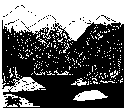
Two hundred fifty years ago
the Tlingits were the only people who lived along the shores of
Southeastern Alaska. If you could go back in time, you could visit
them and see what life was like in "Lingit Aanee" long ago, before
white people came.

You would have to travel to
one of the villages in a wooden canoe-the forests are too
dense, and the mountains too steep to walk far on the land. You might
travel miles and miles along the shore, around islands, across rough
straits before you would see a Tlingit village.
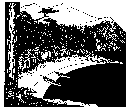
Then one day, you would come
around a point and paddle into a quiet cove with a wide curving
beach. And you would see, at the edge of the beach and out of reach
of the tide, a row of big wooden houses with wide slanting
roofs!
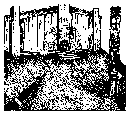
You might paddle up to the
shore, beach your canoe, and walk up to the row of houses. You would
see that each one has a round opening for a door, and the opening is
covered with a skin. Three or four steps lead from the beach up to
the doorway.
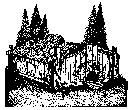
You might decide to walk
around one of the houses. It is very large-large enough for 30
or 40 people to live in it! Its walls are made of wooden planks and
its slanting roof is covered with squares of bark. The bark is held
down with big rocks and logs.
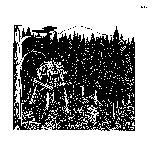
As you walk around the
house, you would see that there are no windows or doors on the sides
or back. A tall log with notches cut in one side leans against one
side of the house. And behind the house, you would see a cache built
up high, out of reach of foxes, dogs, or wolverines. Behind the
cache, you would see the forest-spruce, cedar and hemlock
trees, tall and full.
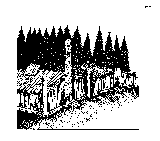
If it were fall, you might
suddenly realize that it is very quiet in the village. You haven't
seen a single person since you beached the canoe! You realize that
everyone must be at fish camp, but you decide to go into one of the
houses anyway. You won't bother anything inside, and you're sure the
people won't mind if you just look around.
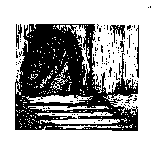
First, you have to push
aside the skin hanging in the doorway and crawl through the round
hole.

You crawl inside on hands
and knees and blink. It is dark inside. As your eyes get used to the
dim light, you notice that a bit of light is coming into the house
from the ceiling. You look up and see a big hole cut in the middle of
the ceiling. The hole is partly covered by a wooden
board.
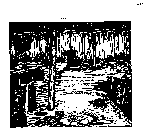
You look down from the
ceiling and notice that on the ground right underneath the hole there
is a hearth, dug out of the ground and lined with stones. There are
bits of charred wood and a few burned bones in the
fireplace.
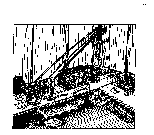
You can see better in the
dark room now. You look around and see that you are standing in a
very big room. In fact, the whole house seems to be one big room. You
are standing on a platform that is about three feet wide. The
platform is made of wooden planks. It goes all around the house, and
all along it you see stone and wood tools, wooden boxes, baskets,
spears--the things that belong to the people who live in this
house.
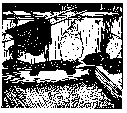
There are rolled up deer and
bear skins against the walls.
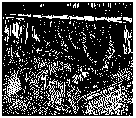
There are mats woven of thin
strips of cedar bark hanging on the walls. Mats are also hanging
across the platform in some places, dividing it into separate little
rooms.
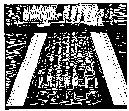
There are strings of clam
shell and dried fish hanging from the rafters, right under the
ceiling.
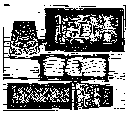
You walk along the platform,
all around the house, and peek inside some of the wooden boxes. Some
have dried fish or berries in them. Others have fancy skin or bark
clothing. One box even has a suit of wooden armor in
it!
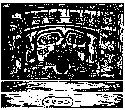
You keep walking along the
platform. When you get to the back of the house, farthest away from
the door, you look more closely at the back wall. It has carved and
painted designs on it. And then you see, for the first time, that
there is a round door in the middle of the wall! There must be
another room through the door!
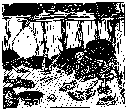
You crawl through the round
doorway into a room. There are more rolled up skins against the wall,
more boxes and baskets filled with food, clothing, and tools. And
there are wooden masks, and decorated sticks and huge wooden dishes
with carvings on the outside too!
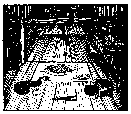
You crawl back through the
doorway into the main part of the house. You step off the platform
onto the floor. The floor is covered with wooden planks, all the way
to the fire pit. You notice some long wooden tongs, spoons, and some
more boxes and baskets near the fireplace.
You might begin to feel a
little scared, being in such a big, dark house all alone. You might
wish there was a fire in the fire pit, and people telling jokes and
cooking meals and mending tools and making baskets. And if you are
lucky, you might hear sounds of canoes landing on the beach and
people returning home from their summer fish camps!
This is a pre-publication copy being
distributed for purposes of field testing and correction only, not to
be reproduced without the permission of the Alaska Bilingual
Education Center.
Third Grade Lesson
Plans
Unit: Planning and Hosting a
Tlingit Potlatch
Lesson: Potlatch Procedures
Materials:
- Potlatch script developed by Austin
Hammond (Tlingit elder)
- Raven speaker's staff*
- Example of a gift to be made for the
second graders
- Resource person for Raven
Peace Song*
* Available from the Indian Studies
Office
Objectives:
- Students will listen to the teacher
explain the sequence of the potlatch that they are
hosting
- Students will be able to verbally
summarize what is expected of them at their potlatch
Introduction
(Set/Purpose)
Review from yesterday's lesson. Ask the
students what a potlatch is. Why were potlatches given? Why are we
going to host a potlatch? Do you remember which clan we will be
representing? Which clan will the second grade class be
representing?
Tell the class that we will be going over
our potlatch script in detail today. We'll know what we should be
doing the day of our potlatch.
We will need to have a chief from this
class. The teacher determines who that will be. The chief should be a
boy that is willing to memorize several lines and be able to speak in
front of a large group of people.
Our chief will need to hire three Eagle
artists to make our Raven House front design. After the design is
complete, we will host a potlatch and invite the second grade Eagle
clan.
Now, go over the potlatch script in
detail with the students. Explain each step to the students. Explain
that the hosts are responsible for preparing all of the food and they
are to make beautiful gifts to give to the Eagle clan. Show the
students the gift that they will be making for the Eagle clan...This
can be a beaded medallion or paper medallion with an Eagle design on
it, and Eagle mask, etc.
Activity (Instruction and Guided
Practice)
Tell the students that before the
potlatch begins, they'll line up single file. Then when the first
person in line goes to the potlatch room, he or she will find button
blankets along the wall. That first person must go to the first
button blanket to put on. The second person in line will take the
second button blanket and so on. (This prevents chaos.)
After putting on the button blanket,
everyone will sit quietly while we wait for our guests to
canoe to our potlatch.
Our Raven chief will be standing next to
our Tlingit elder. As the second grade Eagles enter, their Nakaani
will show everyone where to sit.
Then the speaking begins in the script.
Read this to the class. Let them know that whenever one of the chiefs
stomps his speaker staff three times, it means, "silence, I will
speak now."
When the Raven chief asks his clan to
serve food, have the third grade Ravens get in their single file.
They get a plate of food to give away to the second graders. Again,
the first person in line goes to the first second grader to serve
their food, etc.
The third graders must remember who they
served their food to, because this will be the same person that they
give their gift to later during the potlatch.
After the third graders have served a
plate of food, they get back at the end of the line and get another
plate of food for themselves.
The Raven chief does not serve food.
Also, make sure that the Tlingit elder, Tlingit singer/dancer, Eagle
chief, the Nakaani, and the second grade teacher get served a plate
of food, too.
Reinforce to the students that they may
be trying new foods. Try it and if you don't like it, place it to the
side of your plate. Don't make faces or noises, because this does not
show respect!
After eating, the trash will be
collected. Then, the Raven chief will tell his clan to give away the
gifts. Remind the students to give their gift to the same person that
they served the food to.
Then, the Eagle chief will thank the
Ravens. At that point, the Tlingit dancer/singer will play the
Raven Peace Song. The Ravens will sing and dance to
this song. Tell the students that we are fortunate that a Tlingit
will come and teach us this song. This song belongs to someone else
and not everyone can teach this song.
Reinforce to the students that we need to
show respect toward this person when they come into our classroom to
teach us the Raven Peace Song.
After we sing and dance at the potlatch,
our Raven chief will ask the Nakaani to give an extra special gift to
the three second grade artists that made our Raven House front
design. This gift can be magic markers, colored pencils,
etc.
Then the Eagle chief will thank us for
the special gifts. Our Raven chief will respond. Again, the Eagle
chief will thank the Ravens. All the Eagles will stand up and say
"Goonulcheesh", (thank you), in Tlingit.
At this point, all the Ravens should
stand in their line and have their hands out. As the second graders
leave our potlatch, shake their hand and say "Goonulcheesh" to our
Tlingit elder, Tlingit singer/dancer, the adults that prepared the
food and the parents.
Next, take off the button blanket and
neatly fold it up and place it where you found it.
Activity (Closure)
After the potlatch, ask the students what
they learned about the potlatch. Did they notice the amount of work
that the Tlingits must have gone through to prepare for their
potlatches?
RAVEN-EAGLE POTLATCH
CEREMONY
1. Eagles arrive in their canoe, singing
the Getting Ready Song.
2. Eagles put on dance regalia and enter,
singing the Going In Song.
3. Nakaani seats Eagles along both sides
of the room.
Raven Host
- (asks Nakaani) "Are any more coming?"
Nakaani - "No, all are
here."
4. Raven Host - "My dear
Grandfathers, my fathers, my father's brothers, my aunts, I am glad
you have come. All the people will see the Raven design that you have
made for our house and we will feel better.
Eagle Headperson
- "My sons, we wanted to do this to hold your name high, so
the people will know that you live here. We will be glad, too, my
dear sons."
5. Raven Host -
"Ravens, please serve the food to the Eagle clan." (Everyone will
eat, the Ravens serving the Eagles before they eat).
6. Raven Host - "We made
these medallions for you so that you can dance with us. You can keep
it to take home to think of us."
Eagle Headperson
- "Goonulcheesh. We will think of you every time we wear
our medallions and dance, my dear sons." (Ravens and Eagles will
sing and dance the Raven Flirting Song).
7. Raven Host -
"Grandpa (or our Tlingit elder) would like to say a few words
now.
8. Raven Host - "Now
we want to pay you for the Raven design that you have made for us.
Nakaani, come here to pay our artists." (Nakaani will pass treats to
the Eagle artists).
Eagle Headperson
- "Thank you for what you have given us. We will enjoy it.
Goonulcheesh."
9. Raven Host - "We know
how you love us. You show us by your patience in sitting with us. And
now it is your turn to speak."
Eagle Headperson
- "Thank you for inviting us. We appreciate it. Now we will
hold our head high when we see your new house front. The ones who
are sitting here feel the same and I'm going to ask them to stand
to say thank you." (Eagles all stand and say,
"Goonulcheesh")
10. Eagles leave, singing the
Going Out Song. (They shake the Raven's hands as
they walk out).
Third Grade Lesson
Plan
Unit: Planning and Hosting a
Tlingit Potlatch
Lesson: Potlatch Gifts
Materials:
- The Bentwood Box by Nan
McNutt*
- 30 medallion designs and
instructions*
- 30 medallion kits*
- For paper medallions: glue sticks,
scissors, crayons or colored pencils
- For beaded medallions: tracing paper,
paper punch, marker
Preparation:
Depending upon class time, choose either
the paper medallion kit which takes 1.5 days or the beaded medallion
kit which takes 3 days. Prepare needed materials as stated in the
instruction handouts.
* Available from the Indian Studies
Office
Objectives:
- Students will list the traditional
Tlingit colors and how they were made
- Students will label the basic
northwest coast design elements
- Students will make a gift to be given
to a second grader at their potlatch
- Students will practice their patience
and sharing skills
Introduction
(Set/Purpose)
Explain to the students that the Tlingits
used only a few colors. They made white, red, black and blue-green
from the natural resources. (Refer to Nan McNutt's book, The
Bentwood Box.) One way that these colors were made was through
the combination of salmon eggs with white clay or shells to produce
white. Salmon eggs and charcoal or graphite to make black. Red clay
and salmon eggs made red. The use of plants, berries, etc. were also
used to produce dyes.
Then tell the students that the Tlingits
used similar design elements throughout their art works. (Refer to
Nan McNutts book, The Bentwood Box.) Draw these shapes on the
chalkboard.
Activity (Instruction)
Reinforce the design elements by giving
the students a Tlingit design to label the design elements. (Refer to
handout sheet of a sockeye salmon, or gaat in Tlingit.) Also, have
them write the Tlingit colors onto the same handout sheet.
Activity (Guided
Practice)
Students will label the design elements
on the salmon and list out the Tlingit colors.
Teacher Note:
Two medallion designs are shared on the
following pages to offer you choice in consideration for the time
available.
Third Grade Lesson
Plans
Unit: Planning and Hosting a
Tlingit Potlatch
Lesson: Learning a Potlatch Song
Materials:
- Tlingit resource person to teach
The Raven Peace song and the dance movements that
accompany the song
- Drum and drumstick*
* Available from the Indian Studies
Office
Objectives:
- The students will learn the history
of one clan song and how it is used today
- The students will begin to learn the
words to The Raven Peace song and the dance
movements that accompany it
Introduction
(Set/Purpose)
Introduce the Tlingit resource person.
Remind the students to show their respect. This song is owned by the
Raven clan. Not just anyone can teach this song. You need permission
from an eider to teach the song. We are fortunate to have someone
come and share their knowledge with us. The resource person will be
your teacher. This song is about a Raven flirting with an
Eagle.
Activity (Instruction and Guided
Practice)
The resource person will sing and the
students will follow along. Then the resource person will demonstrate
how the girls dance and how the boys dance. All students will try
their skill at dancing. The teacher becomes the assistant for the
resource person. The teacher will help whenever possible.
Activity (Independent
Practice)
Tell the students to practice singing
The Raven Peace song and practice their dance
movements.
Activity (Closure)
Have the students thank the resource
person for teaching them how to sing and dance.
Third Grade Lesson
Plans
Unit: Planning and Hosting a
Tlingit Potlatch
Lesson: Potlatch Day
Materials:
- A Tlingit elder to speak at the
potlatch
- A Tlingit singer/dancer to help with
the songs
- Adults to help prepare the native
foods and to help pass out the food to the parents and
guests
- One large room
-- larger
than a normal size classroom, but smaller than a gym
- Decorate the inside of the room with
Tlingit artifacts, i.e., i.e., wooden platforms, varieties of furs
to lay on the floors and on top of the wooden platforms, button
blankets to hang on walls, fake fire pit with fake fish roasting,
bentwood boxes, baskets, etc. (Refer to potlatch
picture)
- Decorate the outside of the room with
the second graders' Raven design hung above the door. Use duct
tape, scissors, and staplers to hang the Raven design and any
other designs being used
- Tlingit foods such as smoked salmon
(prepared by the second grade class), berries, herring eggs, black
or red seaweed, pieces of eulachon fish and halibut,
etc.
- An electric mixer to whip the
soapberries, knife, cutting board, hot plate and pot to boil the
herring eggs, a platter and a table to place the foods
on
- The food will be served by the third
graders. The following is needed to serve the food: small paper
plates for two classes, small paper cups and plastic spoons for
the berries
- Gifts for the Eagle artists (i.e.,
magic markers, crayons, etc.)
Preparation:
It takes two to three hours to decorate
the potlatch room. It takes another hour to prepare the food for the
potlatch.
* All materials are prepared by the
Indian Studies Office
Objectives:
- Students will participate in a
potlatch
- Students will learn to appreciate the
concept of respect toward others, especially their
elders
- Students will taste different Tlingit
foods
- Students will sing and dance the
Raven Peace Song
- Students will give food to the second
graders
- Students will give a gift to the
second graders
- Students will observe what occurs at
a potlatch
- Students will listen to an elder talk
about respect toward everyone and everything
Introduction
(Set/Purpose)
Before the potlatch begins, remind the
students that this potlatch is a time of respect. Ask them how we
show our respect. Briefly, go over the potlatch script once
more.
Activity (Instruction and Guided
Practice)
Have the students put both the Eagle and
the Raven medallions around their necks. Line students in one line
with the leader in front. Dress the leader in a special button
blanket, cedar bark hat and a speaker's staff.
Take the students to the potlatch room.
Have them put on their tunics or button blankets and sit quietly
while we wait for our guests to arrive.
Refer to Potlatch Procedures for detailed
instructions of what is expected at the potlatch.
Activity (Closure)
Have the students thank their Eagle
guests, parents, Tlingit elder, Tlingit singer/dancer and the adults
preparing the food.
Students take off button blankets and
neatly fold them and place them back where they originally found
them.
Activity (Independent
Practice)
Ask the students to write down their
thoughts about the potlatch. Have them share this experience with
their families.
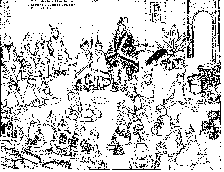
Click here to see bigger
image
ACTIVITY IDEAS FOR
|
MATHEMATICS
|
|
SCIENCE
|
|
ART
|
|
READING
|
|
LANGUAGE ARTS
|
|
OTHER
|
Third Grade
Resources
Available from the Indian Studies
Program
Books for Students:
In A Tlingit Winter House, by
Patrica Partnow, Anchorage School District
Lingit Aanee, by Patricia Partnow, Anchorage School
District
Clan Rule Book, by Patricia Partnow, Anch. School
District
Books for the Teacher:
The Bentwood Box, by Nan McNutt,
The Workshop, Seattle
The People of the Totem, by Norman Bancroft-Hunt & Werner
Forman
Objects of Pride, by Allen Wardwell
The Box of Daylight, by Bill Holm
The Tlingit Way of Life Long Ago, by Maude Simpson &
Esther Billman, Sheldon Jackson Museum
Effective Practices in Indian Education, Teacher's Monograph,
by Floy C. Pepper, Northwest Regional Educational
Laboratory
Study Prints:
Large language map of Alaska
Lingit Aanee poster
Tlingit clothing
Interior/Exterior of Clan House
Canoes
Native foods
Other Resources Available for the
Indian Studies Program:
Raven Speaker's staff
Drum and drumstick
Button Blankets
Fake fire
Fake fish roasting
Bentwood Boxes
Tunics
Headbands
Diskettes for use with Apple II or
Apple III:
Alaska Natives the First People, Part
Four, by Larry & Martha Stevens
Tlingit Clans, by Patricia Partnow, Anchorage School
District
Resource People:
Contact the Indian Studies
Program for assistance in finding people with experience
as:
singers and dancers
storytellers
artisans-
Books for the Teachers
(continued)
Any of the Christie Harris series (for
retelling stories to children), Atheneum
Raven's Cry (Haida history)
Once Upon A Totem
Once More Upon A Totem
The Trouble with Princesses
Mouse Woman and the Muddleheads
Sky Man On the Totem Pole
Mouse Woman and the Mischief Makers
Mouse Woman and the Vanished Princesses
Video Tapes:
Salmon, Catch To Can, Alaska Dept.
of Fish & Game, (Alaska State Film Library)
The Choice Is Ours, U.S. Forest Service (Alaska State Film
Library)
The Shadow and the Spirit, Canadian Broadcasting
Corporation
Haa Shagoon, Austin Hammond & The Chilkat Indian
Association (Alaska State Film Library)
Potlatch To A Monument, Alaska State Film Library
First Americans' Emphasis Week, KTOO (Alaska State Film
Library)
Films:
Potlatch People (16mm), Alaska
State Library
Richard's Totem Pole (16mm), Alaska State Library
Cassette Tapes:
Recorded Raven Creation Stories
Recorded Tlingit Legends
Potlatch songs
Study Prints:
Photograph of a bark house
Photograph of a traditional Tlingit village
Photograph of the Whale House interior, Alaska State Museum
Canoes with sails photograph, Sheldon Museum, Haines
Photograph of Auke village (in town), Alaska State Museum
Photograph of Tlingits dressed for a potlatch, Alaska State
Museum
Living by the Seasons, Juneau Indian Studies Program
Tlingit Clan Designs, Juneau Indian Studies Program
Other Resources Available from the
Indian Studies Program:
Tlingit Winter House Parts
poles, 2x4's and cover cedar platform animal hides seal with
removable insides seal oil lamp
Potlatch Materials:
Resource People:
Contact the Indian Studies Program for
assistance in finding people with expertise as:
- Historians
- Singers & dancers
- Grandparents with subsistence
knowledge
- Storytellers
- Artisans
CONTENTS
Preface
Acknowledgments
Introduction
|
Kindergarten
Teacher Overview
Teacher Summary
Lesson Plans/Handouts
Teacher Activity Worksheet
Resource Listing
|
Third Grade
Teacher Overview
Teacher Summary
Lesson Plans/Handouts
Teacher Activity Worksheet
Resource Listing
|
|
First Grade
Teacher Overview
Teacher Summary
Lesson Plans/Handouts
Teacher Activity Worksheet
Resource Listing
|
Fourth
Grade
Teacher Overview
Teacher Summary
Lesson Plans/Handouts
Teacher Activity Worksheet
Resource Listing
|
|
Second
Grade
Teacher Overview
Teacher Summary
Lesson Plans/Handouts
Teacher Activity Worksheet
Resource Listing
|
Fifth Grade
Teacher Overview
Teacher Summary
Lesson Plans/Handouts
Teacher Activity Worksheet
Resource Listing
|
|